duluth
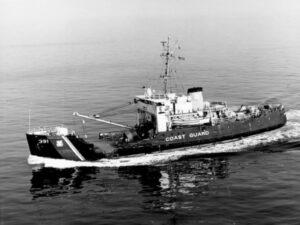 The USCGC Blackthorn (WLB-391) was a 180-foot seagoing buoy tender for the US Coast Guard. A buoy tender is a type of vessel used to maintain and replace navigational buoys. Prior to navigational buoys, ships might run into rocks, small almost submerged islands, or coral reefs. It would be nice if every underwater danger could have a lighthouse, but that just isn’t feasible. Buoys, on the other hand, and markers serve to direct the operator of the water vessels on the safe course to take. They warn the operator of the underlying dangers in the waterways. Navigation buoys and markers are also effective navigation aid in directing the water vessel operator on the best route to use. They aid in determining the safest way through the waters.
The USCGC Blackthorn (WLB-391) was a 180-foot seagoing buoy tender for the US Coast Guard. A buoy tender is a type of vessel used to maintain and replace navigational buoys. Prior to navigational buoys, ships might run into rocks, small almost submerged islands, or coral reefs. It would be nice if every underwater danger could have a lighthouse, but that just isn’t feasible. Buoys, on the other hand, and markers serve to direct the operator of the water vessels on the safe course to take. They warn the operator of the underlying dangers in the waterways. Navigation buoys and markers are also effective navigation aid in directing the water vessel operator on the best route to use. They aid in determining the safest way through the waters.
The Blackthorn was one of 39 original 180-foot seagoing buoy tenders built between 1942-1944. All but one of the original tenders, USCGC Ironwood (WLB-297), were built in Duluth, Minnesota, which makes me wonder if my Uncle Bill Spencer, or his sisters, Laura Fredrick and Ruth Wolfe might have worked on it. Blackthorn’s preliminary design was completed by the United States Lighthouse Service and the final design was produced by Marine Iron and Shipbuilding Corporation in Duluth. On May 21, 1943, the keel was laid, the vessel was launched on July 20, 1943, and commissioned on March 27, 1944. The original cost for the hull and machinery was $876,403.
The Blackthorn was initially assigned to the Great Lakes for ice-breaking duties, but was resigned to San Pedro, California after just a few months. For several years the vessel served in San Pedro and then it was moved to the gulf coast region to serve in Mobile, Alabama. From there it was transferred to Galveston, Texas for the final years of its service until it was involved in an accident.
In 1979-1980, Blackthorn underwent a major overhaul in Tampa, Florida. The work was finished and on January 28, 1980, while leaving Tampa Bay after the completion of the overhaul, she collided with the tanker SS Capricorn near the Tampa Bay Sunshine Skyway Bridge. The Blackthorn capsized resulting in the deaths of 23 crew members. The cutter was raised for the investigation, but ultimately, instead of fixing it, Blackthorn was scuttled in the Gulf of Mexico after the investigation was complete. She is currently serving as an artificial reef for recreational diving and fishing.

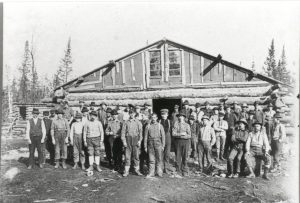 The port city of my birth, Superior, Wisconsin was founded on November 6, 1854 and incorporated March 25 1889. The city’s slogan soon became, “Where Sail Meets Rail,” because it was port connection between the shipping industry and the railroad. Much of Superior’s history parallels its sister city of Duluth’s, but Superior has been around longer than Duluth, which is also known as the Zenith City. Of course, the area had people there before that…there were Ojibwe Indians, and French traders that are known to be in the area in the early 1600s.
The port city of my birth, Superior, Wisconsin was founded on November 6, 1854 and incorporated March 25 1889. The city’s slogan soon became, “Where Sail Meets Rail,” because it was port connection between the shipping industry and the railroad. Much of Superior’s history parallels its sister city of Duluth’s, but Superior has been around longer than Duluth, which is also known as the Zenith City. Of course, the area had people there before that…there were Ojibwe Indians, and French traders that are known to be in the area in the early 1600s.
After the Ojibwe settled in the area and set up an encampment on present-day Madeline Island, the French started arriving. In 1618 voyageur Etienne Brulé paddled along Lake Superior’s south shore where he encountered the Ojibwe tribe, but he also found copper specimens. Brulé went back to Quebec with the copper samples, and a glowing report of the region. French traders and missionaries began settling the area a short time later, and a Lake Superior tributary was named for Brulé. Father Claude Jean Allouez, was one of those missionaries. His is often credited with the development of an early map of the region. Superior’s Allouez neighborhood takes its name from the Catholic missionary. The area was developed quickly after that, and by 1700 the area was crawling with French traders. The French traders developed a good working relationship with the Ojibwe people.
The Ojibwe continued to get along well with the French, but not so much the British, who ruled the area after 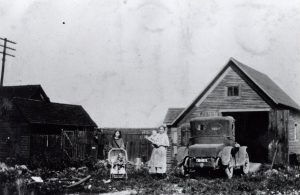
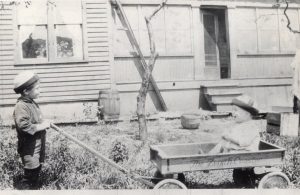 the French, but that ended with the America Revolution and the Treaty of Peace in 1783. The British weren’t as good to the Ojibwe as the French had been. Treaties with the Ojibwe would give more territory to settlers of European descent, and by 1847 the United States had taken control of all lands along Lake Superior’s south shore.
the French, but that ended with the America Revolution and the Treaty of Peace in 1783. The British weren’t as good to the Ojibwe as the French had been. Treaties with the Ojibwe would give more territory to settlers of European descent, and by 1847 the United States had taken control of all lands along Lake Superior’s south shore.
In 1854 the first copper claims were staked at the mouth of the Nemadji River…some say it was actually 1853. The Village of Superior became the county seat of the newly formed Douglas County that same year. The village grew quickly and within two years, about 2,500 people called Superior home. Unfortunately, with the financial panic of 1857, the town’s population stagnated through the end of the Civil War. The building of the Duluth Ship Canal in 1871, which was followed by the Panic of 1873. pretty much crushed Superior’s economic future. Things began to look up when in 1885, Robert Belknap and General John Henry Hammond’s Land and River Improvement Company established West Superior. Immediately they began building elevators, docks, and industrial railroads. In 1890, Superior City and West Superior merged, The city’s population fluctuated, as a boom town will, between 1887 and 1893, and then another financial panic halted progress. Over the years since then, Superior’s population has had it’s ups and down, as has it’s sister city, Duluth, but it has remained about one fourth the size of its twin across the bay.
My great grandparents, Carl and Albertine Schumacher lived in the Goodhue, Minnesota area, when my grandmother Anna was born, but my grandparents Allen and Anna Spencer lived in Superior. That is where my 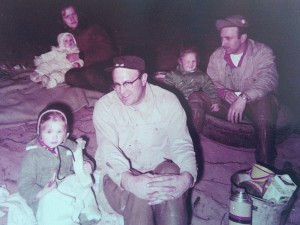
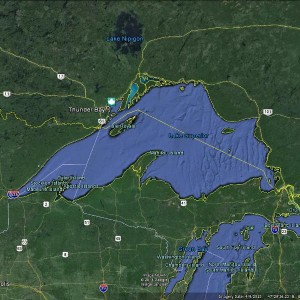 dad, Allen Spencer was born, as were my sister, Cheryl and I. We didn’t live in Superior for all of our lives, just 3 and 5 years, but the area remains in our blood, and in our hearts. It could be partly because of all the trips our family made back to Superior, but I don’t think that’s totally it, because there is just something about knowing that you came from a place, that will always make it special. Superior, Wisconsin is a very special place, that will always be a part of me and my sister, Cheryl too.
dad, Allen Spencer was born, as were my sister, Cheryl and I. We didn’t live in Superior for all of our lives, just 3 and 5 years, but the area remains in our blood, and in our hearts. It could be partly because of all the trips our family made back to Superior, but I don’t think that’s totally it, because there is just something about knowing that you came from a place, that will always make it special. Superior, Wisconsin is a very special place, that will always be a part of me and my sister, Cheryl too.
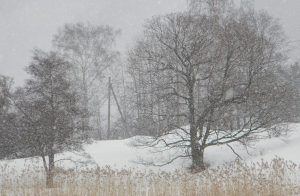 These days, the weather centers can predict storms weeks out. True, they aren’t always as accurate as we would like, but they can also predict corrections and update people with the changes. Of course, it is something we are used to in this day and age, but in 1941, weather centers didn’t exist. That was catastrophic for the people of North Dakota and Minnesota, when a fast-moving and quite severe blizzard hit on March 15th, killing 151 people. The storm came in so quickly that the people had no warning, and as a result far too many lost their lives.
These days, the weather centers can predict storms weeks out. True, they aren’t always as accurate as we would like, but they can also predict corrections and update people with the changes. Of course, it is something we are used to in this day and age, but in 1941, weather centers didn’t exist. That was catastrophic for the people of North Dakota and Minnesota, when a fast-moving and quite severe blizzard hit on March 15th, killing 151 people. The storm came in so quickly that the people had no warning, and as a result far too many lost their lives.
Because of that storm, weather forecasting and reporting systems made important advances that would have prevented the loss of life that occurred due to the sudden storm. The people of North Dakota and northern Minnesota had virtually no warning of the blizzard that was coming, until it swept in suddenly from the west on March 15. In some locations, temperatures dropped 20 degrees in less than 15 minutes. They were hit with 55 mile per hour sustained winds, and gusts reaching 85 miles per hour in Grand Forks and 75 miles per hour in Duluth. The winds 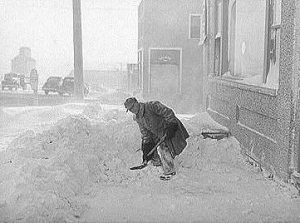 brought blinding snow and huge 7 foot high snow drifts across the states. Most of the victims of the blizzard were traveling in their cars when it hit. Highway 2, running from Duluth, Minnesota to North Dakota, was shut down, as were Highways 75 and 81. Attempts to rescue those stranded in their cars came too late. In one incident, six year old Wilbert Treichel died from exposure to the cold when his parents abandoned their car and attempted to carry him through the blizzard to safety.
brought blinding snow and huge 7 foot high snow drifts across the states. Most of the victims of the blizzard were traveling in their cars when it hit. Highway 2, running from Duluth, Minnesota to North Dakota, was shut down, as were Highways 75 and 81. Attempts to rescue those stranded in their cars came too late. In one incident, six year old Wilbert Treichel died from exposure to the cold when his parents abandoned their car and attempted to carry him through the blizzard to safety.
People attending a basketball game in Moorhead, Minnesota, were stranded at the arena overnight when it was wisely decided that travel was too dangerous for the 2,000 people. Theaters, hotels and stores across the region stayed open through the night to accommodate the many people had visited them, completely unaware that a major storm was approaching. Although the storm was also severe in Manitoba, Canada, only seven people there died because the population was much better prepared for the storm and for dangerous weather in general.
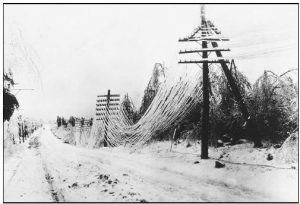
Prior to this time, meteorologists in Chicago were concerned mostly with local weather. It wasn’t that they did not care about the people in surrounding areas, but rather that it was not traditional reporting to report weather for the other areas. In the aftermath of this blizzard, weathermen in North Dakota and Minnesota, who had been under the control of the Chicago meteorology office, which simply paid less attention to events occurring to the north, were allowed autonomy in their reporting. Protected with new technological advances in the wake of the disaster, area residents hoped they would never again be so blind-sided by a winter storm.
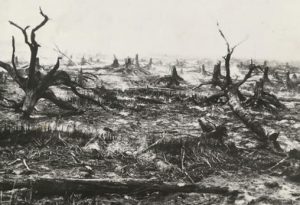 Where there is a forest, there is a possibility of a massive forest fire. The area around Moose Lake in Minnesota, had just such a fire that started on October 12, 1918. The fire, known as the Cloquet-Moose Lake fire, killed hundreds of people and leaving thousands of people homeless. The fire burned a hug area at least 1,500 square miles. The fire, which began at the rail lines near Sturgeon Lake, did the most damage in the Cloquet and Moose Lake areas. This is a region of Minnesota, north of Duluth in the eastern part of the state.
Where there is a forest, there is a possibility of a massive forest fire. The area around Moose Lake in Minnesota, had just such a fire that started on October 12, 1918. The fire, known as the Cloquet-Moose Lake fire, killed hundreds of people and leaving thousands of people homeless. The fire burned a hug area at least 1,500 square miles. The fire, which began at the rail lines near Sturgeon Lake, did the most damage in the Cloquet and Moose Lake areas. This is a region of Minnesota, north of Duluth in the eastern part of the state.
The area was really a recipe for a major disaster of this sort. The timber industry used a crude 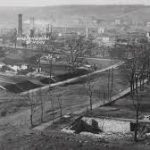 slash method in the thick forests, thus leaving behind dry scraps that were perfect kindling for wildfires. They were not careful where they left the slash either, tending to leave the scraps lying around the rail lines that carried wood from the lumber mills. Train engines of that time often gave off sparks, and when the sparks hit the slash pies, fires were nearly inevitable. The months leading up to October 1918 were very hot and dry, which made matters even worse. The fire began that October 12th, and it quickly spread due to the high winds that day. More than 200 people died in the Moose Lake area, when the fire raced into the community. Many of the local residents tried to escape the raging flames by driving down Highway 73, south of the Kettle River. The
slash method in the thick forests, thus leaving behind dry scraps that were perfect kindling for wildfires. They were not careful where they left the slash either, tending to leave the scraps lying around the rail lines that carried wood from the lumber mills. Train engines of that time often gave off sparks, and when the sparks hit the slash pies, fires were nearly inevitable. The months leading up to October 1918 were very hot and dry, which made matters even worse. The fire began that October 12th, and it quickly spread due to the high winds that day. More than 200 people died in the Moose Lake area, when the fire raced into the community. Many of the local residents tried to escape the raging flames by driving down Highway 73, south of the Kettle River. The  road had a very sharp curve that proved to be too difficult to maneuver for drivers who were speeding away from the flames surrounding them. At least 15 vehicles went off the road within minutes, which resulted in 25 deaths.
road had a very sharp curve that proved to be too difficult to maneuver for drivers who were speeding away from the flames surrounding them. At least 15 vehicles went off the road within minutes, which resulted in 25 deaths.
In all, he fire destroyed 38 towns and villages. The total dead was 453 and another 85 people were seriously burned. The area lost 4,000 houses, 6,000 barns, and 40 schools to the flames.The fire came up so quickly that there was no time to try to get the livestock out, and hundreds of thousands of farm animals also perished in the fire. It was a huge loss for area farmers. In all, the region suffered close to $100 million in damages.
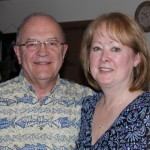
 During our visit to Superior, Wisconsin, my sister, Cheryl Masterson; her daughter, Liz Masterson; and I were treated a couple of wonderful tours of the area. Our cousin, Pam Wendling and her husband Mike took us down to Canal Park, where we watched the Paul R Tragurtha coming into port to pick up a load of coal…that come to Duluth by train from none other than Gillette, Wyoming, by the way. The Paul R Tragurtha is known as the “Queen of the Lakes” and is the longest vessel on the Great Lakes at 1,013 feet 6 inches. Watching that great ship come into port is amazing. It was also great to have Pam and Mike there to give us the lake and ship history. Though we had been to Canal Park before, it just never gets old.
During our visit to Superior, Wisconsin, my sister, Cheryl Masterson; her daughter, Liz Masterson; and I were treated a couple of wonderful tours of the area. Our cousin, Pam Wendling and her husband Mike took us down to Canal Park, where we watched the Paul R Tragurtha coming into port to pick up a load of coal…that come to Duluth by train from none other than Gillette, Wyoming, by the way. The Paul R Tragurtha is known as the “Queen of the Lakes” and is the longest vessel on the Great Lakes at 1,013 feet 6 inches. Watching that great ship come into port is amazing. It was also great to have Pam and Mike there to give us the lake and ship history. Though we had been to Canal Park before, it just never gets old.
Pam and Mike also took us up the North Shore of Lake Superior to Two Harbors, Minnesota, and showed us all the 
 sights in that area. The lighthouse there is really pretty, and we were able to get lots of pictures. There was a ship in the harbor that was loading Taconite, which is a low-grade iron ore. For a long time, when the high-grade natural iron ore was plentiful, Taconite was considered a waste rock and not used. Then, as the supply of high-grade natural ore decreased, industry began to view Taconite as a resource. Had it not been for Mike’s knowledge of all these mining, railroad, and shipping industries in the area, and in the United States, we would have seen these things, but really wouldn’t have know anything about the rich history that went along with it. It takes someone, like Mike, with a love of history to give us that.
sights in that area. The lighthouse there is really pretty, and we were able to get lots of pictures. There was a ship in the harbor that was loading Taconite, which is a low-grade iron ore. For a long time, when the high-grade natural iron ore was plentiful, Taconite was considered a waste rock and not used. Then, as the supply of high-grade natural ore decreased, industry began to view Taconite as a resource. Had it not been for Mike’s knowledge of all these mining, railroad, and shipping industries in the area, and in the United States, we would have seen these things, but really wouldn’t have know anything about the rich history that went along with it. It takes someone, like Mike, with a love of history to give us that.
Pam and Mike also do some hiking in the area, and we were shown some of the beautiful hiking trails, and the 
 beautiful wooded areas around the lake. The streams and waterfalls especially appealed to us. That area has so many more trees that we have in Wyoming, and all that greenery made me long to get out and wander down the trail, but we just didn’t have the time, unfortunately. Pam suggested that Bob and I consider a hiking trip to the area, we may have to try to do that. The tours were beautiful, and the time we spent with them was very special to us. I am so glad that we have reconnected with all of our cousins in the Superior/Duluth area, and all over the nation. Amazing family connections.
beautiful wooded areas around the lake. The streams and waterfalls especially appealed to us. That area has so many more trees that we have in Wyoming, and all that greenery made me long to get out and wander down the trail, but we just didn’t have the time, unfortunately. Pam suggested that Bob and I consider a hiking trip to the area, we may have to try to do that. The tours were beautiful, and the time we spent with them was very special to us. I am so glad that we have reconnected with all of our cousins in the Superior/Duluth area, and all over the nation. Amazing family connections.
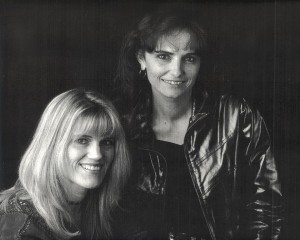 It all started in the late 1990s, in church. That was when two girls, my cousin, Julie Carlson Soukup and her friend, Melody Cox sang together, and found out that they had a God given musical bond. They found that Julie’s words combined with and complimented Melody’s music. Before long they had put together enough songs to record an album. In 1999, Crush Girls was born when the girls recorded their first album, Broken Dove, at Inland Sea Studios in nearby Superior, Wisconsin.
It all started in the late 1990s, in church. That was when two girls, my cousin, Julie Carlson Soukup and her friend, Melody Cox sang together, and found out that they had a God given musical bond. They found that Julie’s words combined with and complimented Melody’s music. Before long they had put together enough songs to record an album. In 1999, Crush Girls was born when the girls recorded their first album, Broken Dove, at Inland Sea Studios in nearby Superior, Wisconsin.
Julie and Melody knew that they had something special, but that’s not enough to grab the attention of the masses. For that you have to be extraordinary. That’s what Julie and Melody were…extraordinary. Before long Crush Girls had built a level of notoriety that allowed them to perform “some very cool gigs” as Melody would say. They played for the Governor of Minnesota, Jesse Ventura and his staff in a formal setting, and then the staff stayed to continue to enjoy the music around a campfire after the governor and his wife went to bed. They played during 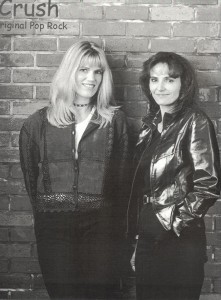 the Blue Angels Show in Duluth, Minnesota, the Harley Davidson Multiple Sclerosis Charity, and the Great American Heartwalk. They had a standing engagement as the house concert group for several months at Giant’s Ridge Golf and Ski Resort, as well as well as regular engagements around the Duluth area, including the Homegrown Festival. Their music continued to grow, and the girls recorded a couple of demos back at the Inland Sea Studios, including headlining song Candy Kisses, which became a crowd favorite.
the Blue Angels Show in Duluth, Minnesota, the Harley Davidson Multiple Sclerosis Charity, and the Great American Heartwalk. They had a standing engagement as the house concert group for several months at Giant’s Ridge Golf and Ski Resort, as well as well as regular engagements around the Duluth area, including the Homegrown Festival. Their music continued to grow, and the girls recorded a couple of demos back at the Inland Sea Studios, including headlining song Candy Kisses, which became a crowd favorite.
As with most things, time stepped in and the girls’ took different paths for a time…a time which Melody called “Crush, the Dark Years.” Nevertheless, she says that Julie and their music were certainly never far from her mind. Melody missed Julie and their musical “children.” She continued to play gigs and always included songs from Crush Girls in the set list. Then, time stepped in again and the music resonated in Julie again. The girls reconnected and have been writing again, but on a deeper and more sincere level. The girls still live a few hundred miles apart…Julie in Duluth, Minnesota and Melody in Asheville, North Carolina, but Melody says that Julie will always be her heart’s twin, with the first cut of their Broken Dove album, I Begin In You as their core. She truly believes that their music will continue and will find a way, and I think determination will bring it to pass.

I tend to agree with Melody, because I don’t think Crush Girls are over. Their latest song, Shores Evermore is the expression of the music finding a way. They are making plans to take some time to step back into the studio. As Melody says, “Much more is stirring in the Crush breeze! So stay tuned ~ more Crush songs are coming!” Having taken the time to listen to some of their songs, I can tell you that each and every one is worth waiting for. I think God certainly knew what He was doing when He joined these two musical hearts together. I hope they will indeed find a way to make more of their music, because I think a lot of people would really enjoy it if they did.
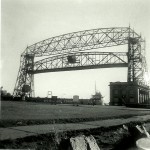 Because I was born in Superior, Wisconsin, located at the tip of Lake Superior, and across the bridge from Duluth, Minnesota, I am interested in all things that have to do with that area. My family moved to Casper, Wyoming when I was three, so I was not raised in that area, but somehow, it is in my blood. I will always have roots I can feel there. We still have a large number of family members there, and we continue to get to know them more and more due to a trip back there, and continued connections on Facebook. For that family we are very grateful, because they are all amazing.
Because I was born in Superior, Wisconsin, located at the tip of Lake Superior, and across the bridge from Duluth, Minnesota, I am interested in all things that have to do with that area. My family moved to Casper, Wyoming when I was three, so I was not raised in that area, but somehow, it is in my blood. I will always have roots I can feel there. We still have a large number of family members there, and we continue to get to know them more and more due to a trip back there, and continued connections on Facebook. For that family we are very grateful, because they are all amazing.
As I said, I love the area around Lake Superior, and the shipping business that comes through there is an amazing thing to watch. In order for shipping to thrive on Lake Superior, they had to have a way to get the big oar boats and other large ships into the port. In 1892, a contest was held to find a solution for the transportation needs to go from Minnesota Point to the other side of the canal that was dug in 1871. a man named John Low Waddell came up with the winning design for a high rise vertical lift bridge. The city of Duluth was eager to build the bridge, but the War Department didn’t like the design, and so the project was cancelled before it started. It really was an unfortunate mistake.
 Later, new plans were drawn up for a structure that would ferry people from one side to the other. This one was designed by Thomas McGilvray, a city engineer. That structure was finished in 1905. The gondola had a capacity of 60 tons and was able to carry 350 people, plus wagons, streetcars, and automobiles. The trip across took about a minutes and the ferry crossed once every five minutes, but as the population grew, the demand for a better way across grew too. They would have to rethink the situation, and amazingly, he firm finally commissioned with designing the new bridge was the descendant of Waddell’s company…the original design winner. The new design, which closely resembles the 1892 concept, is attributed to C.A.P. Turner. I guess they should have used that design in the first place, and it might have saved a lot of money.
Later, new plans were drawn up for a structure that would ferry people from one side to the other. This one was designed by Thomas McGilvray, a city engineer. That structure was finished in 1905. The gondola had a capacity of 60 tons and was able to carry 350 people, plus wagons, streetcars, and automobiles. The trip across took about a minutes and the ferry crossed once every five minutes, but as the population grew, the demand for a better way across grew too. They would have to rethink the situation, and amazingly, he firm finally commissioned with designing the new bridge was the descendant of Waddell’s company…the original design winner. The new design, which closely resembles the 1892 concept, is attributed to C.A.P. Turner. I guess they should have used that design in the first place, and it might have saved a lot of money.
Construction began in 1929. They knew that they had to be able to accommodate the tall ships that would pass through. In the new design, the roadway simply lifted in the middle, and after the ship went through it lowered 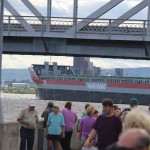 again, becoming a bridge for cars. The design is amazing, and grabs the attention of thousands of people on a regular basis. The new bridge first lifted for a vessel on March 29, 1930. Raising the bridge to its full height of 135 feet takes about a minute. The bridge is raised approximately 5,000 times per year. The bridge span is about 390 feet. As ships pass, there is a customary horn blowing sequence that is copied back. The bridge’s “horn” is actually made up of two Westinghouse Airbrake locomotive horns. Long-short-long-short means to raise the bridge, and Long-short-short is a friendly salute. The onlookers love it, and the crews often wave as well. It is like a parade of ships on a daily basis, and probably the reason that the bridge is so often the subject of pictures of the area. Happy 86th Anniversary to the Duluth Lift Bridge.
again, becoming a bridge for cars. The design is amazing, and grabs the attention of thousands of people on a regular basis. The new bridge first lifted for a vessel on March 29, 1930. Raising the bridge to its full height of 135 feet takes about a minute. The bridge is raised approximately 5,000 times per year. The bridge span is about 390 feet. As ships pass, there is a customary horn blowing sequence that is copied back. The bridge’s “horn” is actually made up of two Westinghouse Airbrake locomotive horns. Long-short-long-short means to raise the bridge, and Long-short-short is a friendly salute. The onlookers love it, and the crews often wave as well. It is like a parade of ships on a daily basis, and probably the reason that the bridge is so often the subject of pictures of the area. Happy 86th Anniversary to the Duluth Lift Bridge.
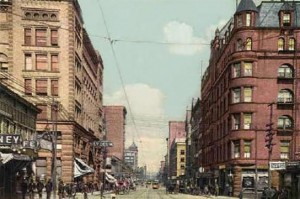 A couple of years ago, my mom, Collene Spencer, my sister, Cheryl Masterson, and I made a trip back to Superior, Wisconsin and Duluth, Minnesota to reconnect, and meet family members there. We had a wonderful trip, and both my sister and I have found sites on Facebook that display pictures of the area. Cheryl and I were both born in Superior, Wisconsin, so we feel a closeness to the area, even though we have not lived there for many years. It is still the area of our roots. Now that we have been back in a more recent time, a continue to feel drawn to the area. The strange thing is that the things I am interested in at this time, are more historic things…some of them, things that no longer exist. In my memory, we didn’t spend a lot of time in Duluth, but I’m probably mistaken on that count…at least to a degree. Superior, Wisconsin and Duluth, Minnesota are so close to each other, that if there were no signs to tell you so, you might not realize that you have left one and entered the other. I’m sure my parents shopped in Duluth, simply because as the larger of the two cities, there was quite likely more variety there.
A couple of years ago, my mom, Collene Spencer, my sister, Cheryl Masterson, and I made a trip back to Superior, Wisconsin and Duluth, Minnesota to reconnect, and meet family members there. We had a wonderful trip, and both my sister and I have found sites on Facebook that display pictures of the area. Cheryl and I were both born in Superior, Wisconsin, so we feel a closeness to the area, even though we have not lived there for many years. It is still the area of our roots. Now that we have been back in a more recent time, a continue to feel drawn to the area. The strange thing is that the things I am interested in at this time, are more historic things…some of them, things that no longer exist. In my memory, we didn’t spend a lot of time in Duluth, but I’m probably mistaken on that count…at least to a degree. Superior, Wisconsin and Duluth, Minnesota are so close to each other, that if there were no signs to tell you so, you might not realize that you have left one and entered the other. I’m sure my parents shopped in Duluth, simply because as the larger of the two cities, there was quite likely more variety there.
Recently, I started looking into some of the history of that general area, and stumbled on something 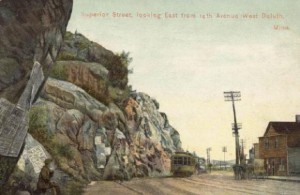 interesting. Duluth had an incline railway. Personally, I like incline railways, but I have never seen one that was in a city. Incline railways seem more like something that you would see at a tourist attractions, than anything that you would use in everyday life. Nevertheless, Duluth, in 1891, had a streetcar line, and in December 1891, the Duluth Street Railway Company opened the incline railway, as part of that street car line. The Incline Railway was on the right-of-way of Seventh Avenue West. The Duluth Street Railway Company had received a charter from the state in 1881 to build a streetcar line for Duluth. The hillside on Seventh Avenue West was too steep for a regular rail line, so they built an incline railway for that area. From it’s base station on Superior Street, the Incline climbed 509 feet in slightly more than half a mile, on a ten foot gauge track. Originally, a pair of forty one by fifteen foot cars counterbalanced each other, one going up while the other one descended. They were built to accommodate four teams and wagons, or up to 250 standing passengers. The Incline was powered by a stationary steam engine at the top. The trip took sixteen minutes, one way…just enough time to make it an enjoyable trip.
interesting. Duluth had an incline railway. Personally, I like incline railways, but I have never seen one that was in a city. Incline railways seem more like something that you would see at a tourist attractions, than anything that you would use in everyday life. Nevertheless, Duluth, in 1891, had a streetcar line, and in December 1891, the Duluth Street Railway Company opened the incline railway, as part of that street car line. The Incline Railway was on the right-of-way of Seventh Avenue West. The Duluth Street Railway Company had received a charter from the state in 1881 to build a streetcar line for Duluth. The hillside on Seventh Avenue West was too steep for a regular rail line, so they built an incline railway for that area. From it’s base station on Superior Street, the Incline climbed 509 feet in slightly more than half a mile, on a ten foot gauge track. Originally, a pair of forty one by fifteen foot cars counterbalanced each other, one going up while the other one descended. They were built to accommodate four teams and wagons, or up to 250 standing passengers. The Incline was powered by a stationary steam engine at the top. The trip took sixteen minutes, one way…just enough time to make it an enjoyable trip.
In 1925, it was noted that the Incline carried an average of 2,170 weekday passengers, while the connecting 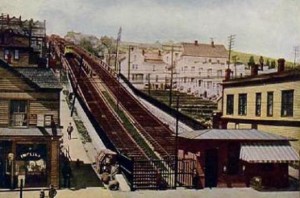 Highland streetcar line carried an average of only 1,114 weekday passengers. I’m sure that was because people like incline railways…they are unique….besides, climbing that hill would not be fun. Hourly checks showed that most riders traveled downhill in the morning rush hour and uphill during the afternoon rush hour. Most likely they were commuting to and from work. The Duluth Incline Railway was never profitable. Nevertheless, it and the Highland line were the last remnants of the streetcar system to be replaced by buses. Their last day of service was September 4, 1939. For that reason, I’m sure that many of the current residents of Duluth don’t even know about the incline railroad. I didn’t either, until I stumbled on it.
Highland streetcar line carried an average of only 1,114 weekday passengers. I’m sure that was because people like incline railways…they are unique….besides, climbing that hill would not be fun. Hourly checks showed that most riders traveled downhill in the morning rush hour and uphill during the afternoon rush hour. Most likely they were commuting to and from work. The Duluth Incline Railway was never profitable. Nevertheless, it and the Highland line were the last remnants of the streetcar system to be replaced by buses. Their last day of service was September 4, 1939. For that reason, I’m sure that many of the current residents of Duluth don’t even know about the incline railroad. I didn’t either, until I stumbled on it.

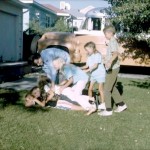 While we were visiting many of our family members in Superior, Wisconsin and Duluth, Minnesota, our cousin, Bill Spencer surprised us with a copy of a slide show that he had put together for his family. We were so busy while we were there, that there was no time to take a look at the slide show. When I got home, I looked at it briefly, but nothing really in depth. Yesterday, I took another look…a longer look. I had no idea what a gold mine that slide show would turn out to be. As I watched it, I felt like I had been instantly transported back in time. It was so fun to look at those old shots of all of us as kids. It also felt just a little bit lonely when I looked at holiday pictures from the time right after we left Superior. Prior to that, we would have most likely been in some of those pictures, and I’m sure that my cousins would agree with me when I say that feels a little bit sad too.
While we were visiting many of our family members in Superior, Wisconsin and Duluth, Minnesota, our cousin, Bill Spencer surprised us with a copy of a slide show that he had put together for his family. We were so busy while we were there, that there was no time to take a look at the slide show. When I got home, I looked at it briefly, but nothing really in depth. Yesterday, I took another look…a longer look. I had no idea what a gold mine that slide show would turn out to be. As I watched it, I felt like I had been instantly transported back in time. It was so fun to look at those old shots of all of us as kids. It also felt just a little bit lonely when I looked at holiday pictures from the time right after we left Superior. Prior to that, we would have most likely been in some of those pictures, and I’m sure that my cousins would agree with me when I say that feels a little bit sad too.
Cheryl and Pam had always been good friends, and the younger kids naturally partnered with Bill and Jim. That could have left me feeling like a third wheel, but I got along just as well with the younger kids, so it worked out very well. The reality was that I thought the stuff the younger kids were doing was more fun most of the time anyway. Not to say that I wouldn’t have wanted to spend time with Cheryl and Pam, but I was a pretty active kid. and the rough housing that the younger kids and I did was quite appealing to me. In fact, I probably instigated much of it…if not all of it.
I was really into gymnastics, with tumbling being my favorite part of it. My sisters and I used to practice our tumbling on the front lawn, so it stood to reason that we would do that when our cousins were there too. We practiced things like cartwheels, hand springs, and touching our toes to our head…which turned out to be a little difficult for my cousin, Jimmy, try as he might. And believe me, his trying was pretty funny. I don’t know if he really thought that he could pull his legs up to his head with his hands, but believe me, you can’t do it. Either you are limber enough, or you aren’t. It’s as simple as that.
The younger kids would do their best to gang up on me, to prove their superiority…or maybe it was just the mere number of them against me, or maybe they had a little help from Aunt Doris. Whatever the case may be, sometimes I found myself out numbered. Of course, it was all in fun, and we had such a good time when they were here or we were there. Just looking at the picture of the dog pile makes me smile. All I can say, is that I’m glad I didn’t have all those kids on top of me. I would have been squished for sure!! What crazy, fun times those were.
Seeing my cousins this summer, took me back to those carefree days. Sometimes, you get used to being away from those you love, and you somehow don’t realize how much we miss those times, until we go back for a 
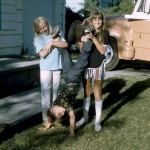 short time. Then, the memories flood back in. You talk for hours about all the old times, and you suddenly realize just how much you have missed those times. Nevertheless, time has marched on, and you can’t go back to when you were young. All you can do is try to keep the memories alive in your memory files, and pull them out once in a while so you can relive those moments. Those days are gone, but the memory lives on to remind you that those were the days, and they were great. Childhood is but a fleeting moment, but those days will always be a part of who we are.
short time. Then, the memories flood back in. You talk for hours about all the old times, and you suddenly realize just how much you have missed those times. Nevertheless, time has marched on, and you can’t go back to when you were young. All you can do is try to keep the memories alive in your memory files, and pull them out once in a while so you can relive those moments. Those days are gone, but the memory lives on to remind you that those were the days, and they were great. Childhood is but a fleeting moment, but those days will always be a part of who we are.

